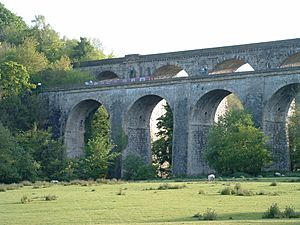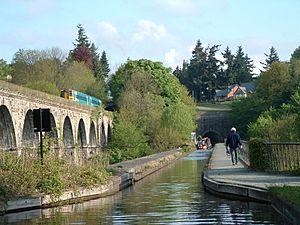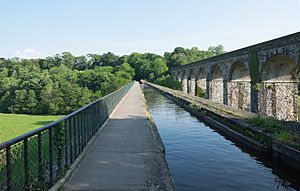Chirk Aqueduct facts for kids
Quick facts for kids Chirk Aqueduct |
|
|---|---|

Chirk Aqueduct and the railway viaduct behind it
|
|
| Coordinates | 52°55′42″N 3°03′44″W / 52.9282°N 3.0622°W |
| OS grid reference | |
| Carries | Llangollen Canal |
| Crosses | Ceiriog Valley |
| Locale | Chirk |
| Maintained by | British Waterways |
| Characteristics | |
| Trough construction | Cast iron |
| Pier construction | Masonry |
| Total length | 710 feet (220 m) |
| Height | 70 feet (21 m) |
| Traversable? | Yes |
| Towpaths | East Side |
| Number of spans | Ten |
| History | |
| Designer | Thomas Telford |
| Construction end | 1801 |
The Chirk Aqueduct is a really cool water bridge! It's about 70 feet (21 meters) high and 710 feet (216 meters) long. This amazing structure carries the Llangollen Canal over the Ceiriog Valley. It's located near Chirk, right on the border between England and Wales.
Contents
Building the Chirk Aqueduct
The Chirk Aqueduct was designed by a famous engineer named Thomas Telford. He created it for the Ellesmere Canal. Another engineer, M. Davidson, helped build it.
Starting the Project
The first stone was placed on June 17, 1796. The aqueduct was finished in 1801. It took about five years to build this impressive structure.
Smart Design Ideas
The aqueduct has a special cast iron trough inside. This trough holds the water for the canal. Stone walls on the outside hide the iron parts. This design was very clever for its time.
The Chirk Aqueduct was one of the first of its kind. It was built after Telford's Longdon-on-Tern Aqueduct. It also helped show how to build the even bigger Pontcysyllte Aqueduct. For a short time, it was the tallest navigable aqueduct ever built.
A Special Landmark
Today, the Chirk Aqueduct is a very important historical site. It is a Grade II* listed building in both England and Wales. This means it's protected because of its special history and design. It is also part of the Pontcysyllte Aqueduct World Heritage Site.
What the Aqueduct Looks Like
The Chirk Aqueduct has ten large arches. Each arch spans about 40 feet (12 meters). The water in the canal is 65 feet (20 meters) above the ground. It is 70 feet (21 meters) above the River Ceiriog below.
Materials Used
The aqueduct is made from yellow sandstone. A person named William Hazledine provided the iron parts. When it was first built, only the bottom of the water trough had iron plates. In 1870, iron plates were added to the sides. This helped stop any water from leaking out.
Nearby Structures
At the north end of the aqueduct, the Chirk Tunnel begins. This tunnel allows the canal to continue towards Llangollen. A railway viaduct was built next to the aqueduct later on. The railway bridge is a little bit taller than the aqueduct.



